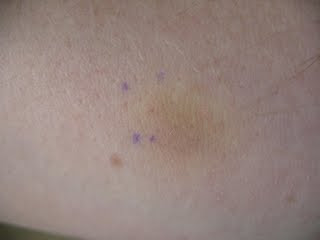I wanted to provide some legit data for all you TB information seekers. Below is a list of terms frequently used in regards to some sort of TB exposure, be it latent TB (what I have) or TB disease (what I don't have). This list was found on The Center for Disease Control website, who are pretty much on top of every single thing in the whole wide world when it comes to anything unsightly, from the plague to pink-eye to the annual flu.
Basic TB Facts
TB Terms
Active TB disease – an illness in which TB bacteria are multiplying and attacking a part of the body, usually the lungs. The symptoms of active TB disease include weakness, weight loss, fever, no appetite, chills, and sweating at night. Other symptoms of active TB disease depend on where in the body the bacteria are growing. If active TB disease is in the lungs (pulmonary TB), the symptoms may include a bad cough, pain in the chest, and coughing up blood. A person with active TB disease may be infectious and spread TB bacteria to others.
BCG– a vaccine for TB named after the French scientists who developed it, Calmette and Guérin. BCG is rarely used in the United States, but it is often given to infants and small children in other countries where TB is common.
Chest x-ray – a picture of the inside of your chest. A chest x-ray is made by exposing a film to x-rays that pass through the chest. A doctor can look at this film to see whether TB bacteria have damaged the lungs.
Contact – a person who has spent time with a person with infectious TB.
Culture – a test to see whether there are TB bacteria in your phlegm or other body fluids. This test can take 2 to 4 weeks in most laboratories.
Directly observed therapy (DOT) – a way of helping patients take their medicine for TB. If you get DOT, you will meet with a health care worker every day or several times a week. You will meet at a place you both agree on. This can be the TB clinic, your home or work, or any other convenient location. You will take your medicine while the health care worker watches.
Extensively drug-resistant TB (XDR TB) - XDR TB is a rare type of TB disease that is resistant to nearly all medicines used to treat TB.
Extrapulmonary TB – active TB disease in any part of the body other than the lungs (for example, the kidney, spine, brain, or lymph nodes).
HIV infection – infection with the human immunodeficiency virus, the virus that causes AIDS (acquired immunodeficiency syndrome). A person with both latent TB infection and HIV infection is at very high risk for active TB disease.
INH or isoniazid – a medicine used to prevent active TB disease in people who have latent TB infection. INH is also one of the four medicines often used to treat active TB disease.
Latent TB infection – a condition in which TB bacteria are alive but inactive in the body. People with latent TB infection have no symptoms, don't feel sick, can't spread TB to others, and usually have a positive skin test reaction. But they may develop active TB disease if they do not receive treatment for latent TB infection.
Multidrug-resistant TB (MDR TB) –active TB disease caused by bacteria resistant to two or more of the most important medicines: INH and RIF.
Mycobacterium tuberculosis – bacteria that cause latent TB infection and active TB disease.
Negative – usually refers to a test result. If you have a negative TB skin test reaction, you probably do not have TB infection.
Positive – usually refers to a test result. If you have a positive TB skin test reaction, you probably have TB infection.
Pulmonary TB – active TB disease that occurs in the lungs, usually producing a cough that lasts 3 weeks or longer. Most active TB disease is pulmonary.
Resistant bacteria – bacteria that can no longer be killed by a certain medicine.
Rifampin (RIF) – one of the four medicines often used to treat active TB disease. It is considered a first-line drug.
Smear – a test to see whether there are TB bacteria in your phlegm. To do this test, lab workers smear the phlegm on a glass slide, stain the slide with a special stain, and look for any TB bacteria on the slide. This test usually takes 1 day to get the results.
Sputum – phlegm coughed up from deep inside the lungs. Sputum is examined for TB bacteria using a smear; part of the sputum can also be used to do a culture.
TB skin test – a test that is often used to find out if you are infected with TB bacteria. A liquid called tuberculin is injected under the skin on the lower part of your arm. If you have a positive reaction to this test, you probably have TB infection. Other tests will be needed to find out if you have latent TB infection or TB disease.
TB blood test – a new test that uses a blood sample to find out if you are infected with TB bacteria. The test measures the response to TB proteins when they are mixed with a small amount of blood. Examples of these special TB blood tests include QuantiFERON®-TB Gold (QFT-G) and T-Spot®.TB test.
Tuberculin or PPD – a liquid that is injected under the skin on the lower part of your arm during a TB skin test. If you have latent TB infection, you will probably have a positive reaction to the tuberculin.
In case any of you have lost count, I took my 30th TB treatment today. I am 1 month out of 9, or 4 weeks out of 36, or 30 days out of 252 through it.







